Rug Size Guide
Many of our customers have to learn this lesson the hard way: don’t settle for a standard-size rug, if you can get the perfect custom size instead. We receive daily requests about what size area rug to order. Often clients make do with a standard-size rug only to discover that it is either too small or too large once it has been arranged in their space. The dimensions of your rug should not be determined by standard sizes widely available or the size and shape of the respective room.
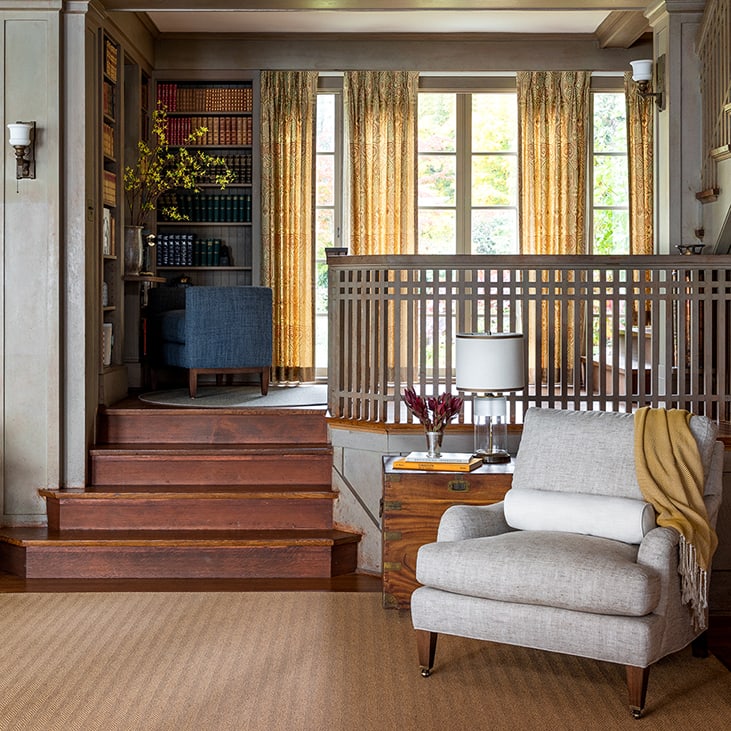
Rug Guides by Room
The ideal rug perfectly anchors your furniture and brings the whole design together. Below are the best tips by room from our team of experts.

Most Popular / Budget Friendly
The most preferred and cost-saving staging option places the two front legs of your sofa and chairs on top of the rug to frame an inviting seating area. This works well for medium and smaller sized rooms.

Large Rooms
If you have a big living room, consider arranging all furniture—your sofa, chairs, coffee and side tables—on top of the rug. Either way, don’t get stingy with four inches plus or minus; if in doubt, opt for the larger total size.

Bold Option
If you want to go an unconventional way, choose a different shape, for example, a round-shaped area rug with either front legs or all legs on the rug.
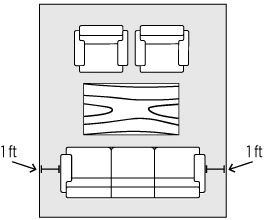
Rule of Thumb
Give your rug another foot on either side of your longest piece of furniture.

Not Recommended
Have you ever heard about the “Dreaded Rug Island?” It’s a term used by designers for a small area rug placed in the center without any seating on it. It makes your furniture look like it is floating in space and does not convey the cohesion your living room deserves especially if your home features an open floor plan.

Final Tip
How to avoid the wall-to-wall carpet look? Leave about 18 inches of bare floor all the way around your area rug and the wall for large rooms and 6-8 inches for smaller spaces. This way your hardwood floor will make your new area rug shine even more.

Large Rooms
If your master bedroom is sizable, we recommend that all furniture is placed on the area rug—queen or king size bed plus two nightstands.

Small to Medium Size Rooms
If your bedroom is smaller, or you have an appealing hardwood floor that you want to showcase, tuck the rug under the bed just up to the nightstands.

Rule of Thumb
You either want the width of the rug to include the end tables or go at least beyond 18 inches on either side of the bed. This way when stepping out of bed, you still experience pure comfort during those crisp, early morning hours.
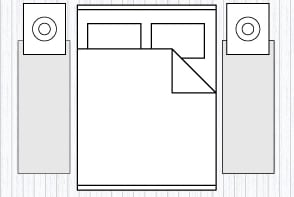
Budget Friendly
The most economical version that gets you the same amount of warmth, but a less grandiose look is throwing a small runner on either side of the bed.

Final Tip
Does your bedroom already have wall-to-wall carpeting? You might not need an area for extra padding, but how about adding a contrasting pattern in harmonizing color hues to lend dimensionality and texture to your bedroom? A medium-size rug placed perpendicular to the bed or a runner alongside the end will do the trick and add to the room's aesthetics.
A fashionable area rug underneath your dining table serves two purposes—providing softness and protection. Dining tables these days come in all shapes and sizes.

Not Recommended
The biggest mistake customers make is buying a standard-sized rug that just fits their table with chairs pushed in about halfway. There is nothing worse than sliding your chair in and out while getting stuck on its rug underneath. Nobody wants to sit on a wobbly chair with some legs on and others off the rug.
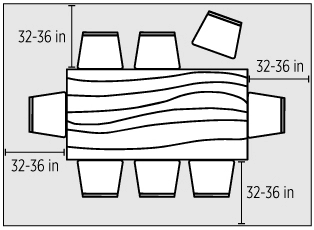
Rule of Thumb
Add about 32 to 36 inches to each side of your table’s dimensions to comfortably move chairs in and out. Whether your table is rectangular, round, or oval, a custom-size rug that adds the buffer mentioned above is the way to go.
Final Tip
What if I have an extendable table? It all depends on how often you use your table’s extensions. If you only entertain large groups two to three times a year, then stick with a rug that fits your unextended table. If in doubt, get a rug that accommodates the table with or without extensions.
Runners are a great way to freshen up the look of your kitchen by adding a splash of color or an intriguing pattern while protecting high-traffic areas from excessive wear and tear.
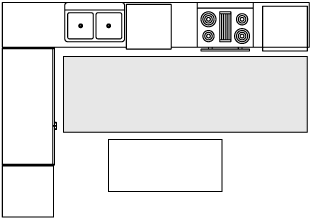
Large Kitchens
For galley kitchens, L-shaped kitchens, or kitchens with an island, place a decent-sized runner with the longest side of your cabinets to cushion most of your steps and protect your tiles or hardwood floors from being banged up by the occasional knife drop.
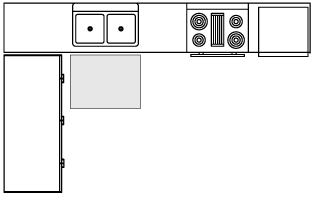
Budget Friendly
For smaller spaces, often found in older houses or one-bedroom apartments, place a stylish, petite area rug where you spend the most time cooking or washing dishes.

Rule of Thumb
How to decide on the width of your rug? Leave at least 3 to 6 inches on each side in small areas and up to 24” in large kitchens for your tile or hardwood floor to remain visible.
Final Tip
Think cleanability and comfort—our SynSisal®, synthetic sisals or sisal blends offer an expansive array of colors and patterns that are durable and easy to clean but still feel soft on your bare feet. All of them are available in the custom size you require.
Who would not want a plush area rug in the bathroom to add warmth and extra comfort? The only problem is that the market’s standard of 24 by 60 inches might not be the perfect fit. Before you order your custom rug, consider the following layout options.
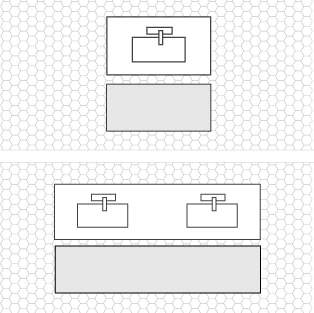
Budget Friendly
Match your bath rug exactly to the length of your single or double vanity. This approach saves money, but still provides warm padding where desired the most.
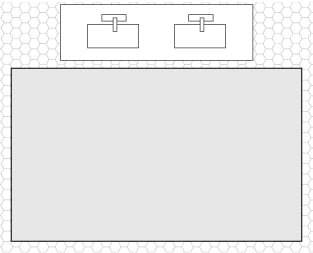
Large Bathrooms
A larger space allows for a more playful approach either in size—place two single area rugs or one large one in front of your double vanity—or in shape—from square to rectangular, from oval to circular, only the size of your bathroom is your limit.

Rule of Thumb
Large or small, when sizing your new bathroom rug, have at least 3 to 6 inches of visible tile or hardwood flooring. You don’t want to cover up what you paid hard money for.
Final Tip
All our wool and wool blends, woven or tufted, make great bathroom rugs and can be customized in size to fit your needs.
Customers rarely think about it, but the most important place to choose the right rug is your entryway. Your foyer area rug conveys the first impression of your home’s style, and you are the shaper of this message: modern versus traditional, minimalist versus luxurious, or energizing versus relaxing. The size might either distract from or add to this message.

Large Hallways
Longer is always better. Entryway rugs catch wet and mud, and the longer they are, the less likely it is that some of that dirt may end up on your beautiful hardwood floors. In any case, your runner should be centered in front of the entrance and guide visitors from one zone to the next.

Small Hallways
If the length of your runner is rather short, add a tough walk-off mat at your front door. This is an efficient way to trap gravel, sand, and mud before it even enters your house.

Rule of Thumb
Leave 3 to 6 inches on each side of your rug for a contrasting showing of the tiles or hardwood floors installed underneath.
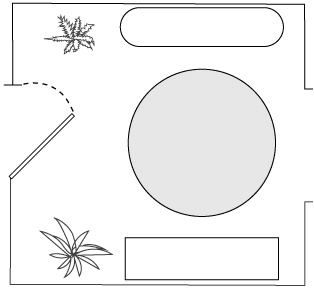
Final Tip
If opening the front door does not allow for a rug, you may want to center your rug in the space or lay it in front of a foyer bench or table.
Outdoor
The recommendations and tips outlined above for specific indoor settings can also be applied in similar outdoor settings. If you have additional questions or can’t wrap your mind around your specific space needs, please chat with our team of experts.
The Art of Rug Layering
No rug sizing guide is complete without addressing the important subject of layering. Layering rugs started as a trend, but it has not gone away for good reasons.
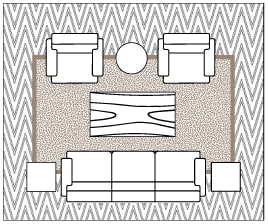
Define Your Space
Layering is just another tool to delineate different areas of usage in a large, open space. When your kitchen freely flows into the dining and living space, the right placement of area rugs will hold each setting separate. In addition, if you already have a rug that is too small for the area you want to define, layering can solve that problem. Layering your small accent rug on top of a neutral, larger base rug, such as sisal or jute, will anchor your furniture.
Set an Accent
Freshen up your space and express your style by adding an area rug. Play with vibrant or calm colors, contrasting or harmonizing patterns and textures. This will also redirect your visitor’s gaze to what is important to you and distract from areas that are not perfect yet.
A word on color, patterns, and texture:
If you love color, be bold and layer pattern onto pattern; aim for complementary but distinct patterns.
If you like patterns but are uneasy about too much color, you may still layer pattern onto pattern, just stay within the same color hues.
If color and pattern aren’t your thing, layer two different textures in neutral tones to create interest and dimensionality.
Most important: have fun and go with your feeling!
Budget Friendly

There are multiple ways to save money while refreshing your flooring. For example, you like your existing area rug, but your furniture setting has outgrown it. You may want to invest in a neutral, larger-size rug as a foundation and layer your hard-to-part area rug on top of it for a completely new look. Or you already worked with layering but are craving a change. Find out the latest flooring trends and hip colors and replace the smaller, accent rug with a fresh design. In both cases, you will save money in the long run. Layering gives you the option to make quick, substantial changes for less money.
Avoid Rookie Mistakes
Make sure you lay down the large, dominant rug so that it emphasizes the orientation of the largest piece of furniture. Avoid tripping hazards. Know that too many patterns cannot tell a cohesive story.